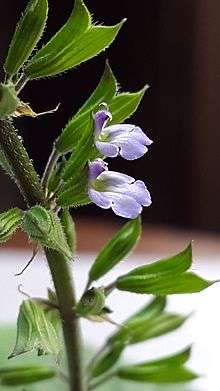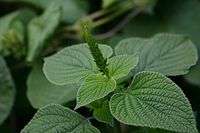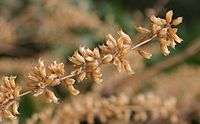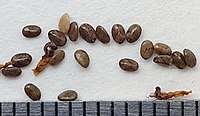Salvia tiliifolia
| Salvia tiliifolia | |
|---|---|
 | |
| Scientific classification | |
| Kingdom: | Plantae |
| (unranked): | Angiosperms |
| (unranked): | Eudicots |
| (unranked): | Asterids |
| Order: | Lamiales |
| Family: | Lamiaceae |
| Genus: | Salvia |
| Species: | S. tiliifolia |
| Binomial name | |
| Salvia tiliifolia | |
| Synonyms | |
|
Salvia tilaefolia Vahl | |
Salvia tiliifolia (lindenleaf sage or Tarahumara chia) is a vigorous, herbaceous annual in the Lamiaceae family that is native to Central America. As a pioneer of abused areas the plant has spread in modern times into: South America as far south as Peru and Bolivia; into Texas and Arizona in the United States; into Africa, including South Africa and Ethiopia; into Yunnan and Sichuan in China.[1][2][3]
Salvia tiliifolia grows up to 1 m (3.3 ft) tall, with broadly ovate and petiolate leaves, 5 to 10 cm (2.0 to 3.9 in) long and 4 to 9 cm (1.6 to 3.5 in) wide, that are slightly pubescent, with veins deeply recessed on the upper surface and exserted on the lower, with the margins finely and regularly crenate, bearing a strong resemblance to those of the Tilia or Linden tree. The inflorescence can be simple or paniculate with a hispid, ribbed calyx. The dark blue corolla is 5 to 10 mm (0.20 to 0.39 in) long. It is morphologically similar to Salvia personata. Seeds are small, dark and patterned.[1][4]
The plant has spread to many countries, commonly growing in cultivated fields. First described as Salvia tiliaefolia by the botanist Martin Henrichsen Vahl in 1794, Salvia tiliifolia has become naturalised or invaded in Mexico, the United States, Ethiopia (1980s), South Africa (1943) and China (1990s). Its foothold in Ethiopia resulted from its presence in grain distributed in a humanitarian aid program following prolonged droughts, after which the species spread rapidly, being strongly aromatic and shunned by grazing and browsing animals.[4]
| Wikimedia Commons has media related to Salvia tiliifolia. |
Gallery



References
- 1 2 Wood, J. R. I. (2007). "The Salvias (Lamiaceae) of Bolivia". Kew Bulletin. Springer. 62 (2): 177–207. JSTOR 20443346.
- ↑ "Salvia tiliifolia Vahl". USDA Plants Profile. United States Department of Agriculture. Retrieved 1 April 2013.
- ↑ Hu, G.X.; Xiang, C.L.; Liu, E.D. (2013). "Invasion status and risk assessment for Salvia tiliifolia, a recently recognised introduction to China". Weed Research. European Weed Research Society. 53 (5): 355–361. doi:10.1111/wre.12030.
- 1 2 Demissew, Sebsebe (February 1996). "A CENTRAL AMERICAN WEEDY SALVIA IN ETHIOPIA" (PDF). Lamiales Newsletter. Royal Botanic Gardens, Kew. 4. ISSN 1358-2305.
External links